When the air turns crisp and the leaves transform into shades of gold, amber, and crimson, it’s the perfect time to refresh your outdoor décor.
One of the easiest and most impactful ways to celebrate the season is through fall planters. These creative arrangements can highlight the beauty of autumn while adding warmth, color, and character to your porch, patio, or garden.
Whether you love traditional fall designs or enjoy experimenting with rustic, modern, or whimsical styles, there are endless ways to create inviting displays.
Here are 10 detailed fall planter ideas to elevate your outdoor space this season.
1. Classic Mums with Pumpkins
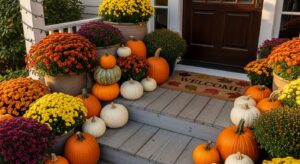
Chrysanthemums, commonly called mums, are fall’s signature flowers. They come in a wide range of rich colors like golden yellow, deep burgundy, warm orange, and soft purple.
Pairing mums with pumpkins creates a timeless and festive display that instantly signals autumn. For visual depth, use a mix of sizes and shapes place larger pumpkins at the base of your planters, layer in medium-sized gourds, and top with clusters of vibrant mums.
This classic combination is ideal for front porch steps or as welcoming accents by your entryway.
2. Ornamental Kale and Cabbage
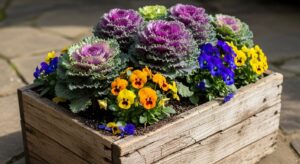
Ornamental kale and cabbage add bold textures and unique colors to your fall planters. Their ruffled leaves, often highlighted in shades of green, purple, and cream, provide contrast against softer blooms.
These hardy plants thrive in cooler temperatures, which means they last longer into the season when many other flowers have faded.
To maximize their visual appeal, combine ornamental kale with pansies, violas, or mums in large containers for a layered, eye-catching arrangement that stands out even as the weather cools.
3. Rustic Wooden Crates and Barrel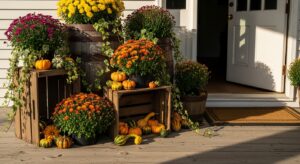
Instead of using traditional pots, try rustic containers such as wooden crates, whiskey barrels, or galvanized tubs.
Their weathered look enhances the cozy, countryside feel of fall. These containers are perfect for farmhouse-style décor and pair beautifully with seasonal plants like mums, ornamental grasses, or trailing ivy.
To complete the rustic vibe, you can tuck in dried corn husks, branches, or small gourds for a more natural, harvest-inspired look.
4. Foliage and Branch Accents
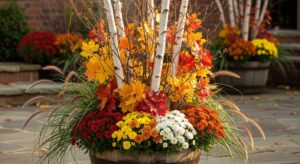
Adding height and structure to your planters creates visual drama and balance. Branches, birch logs, maple leaves, or twigs can be arranged in the center or back of a container to draw the eye upward.
These natural accents not only complement flowers but also bring texture and movement to the overall design.
For a more modern look, consider spray-painting branches in metallic shades like gold, bronze, or copper to add a touch of seasonal elegance.
5. Pumpkin Planters
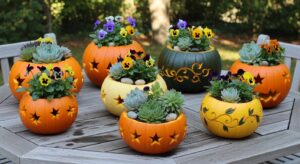
A creative and eco-friendly idea is to use pumpkins themselves as planters.
Simply hollow out a pumpkin, fill it with soil, and add your favorite seasonal flowers like pansies, succulents, or mums.
The natural orange, white, or striped skin of the pumpkin adds charm while keeping the arrangement festive.
Pumpkin planters are especially striking when displayed in groups of varying sizes, making them perfect for front steps, outdoor tables, or garden pathways.
6. Harvest-Inspired Mix
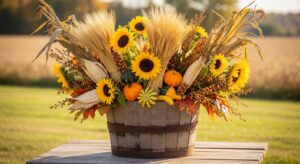
Celebrate the abundance of the season by incorporating elements from the harvest into your planters.
Dried corn stalks, bundles of wheat, ornamental grasses, and even dried sunflowers bring rustic character and authenticity to your displays.
These natural additions provide height and texture while connecting your décor to fall traditions.
Pair them with deep-hued blooms like marigolds or chrysanthemums to create a warm, welcoming atmosphere.
7. Seasonal Blooms Beyond Mums
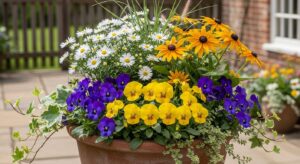
While mums are the most popular fall flower, there are many other seasonal blooms that can brighten your space.
Pansies, violas, asters, and black-eyed Susans all thrive in cooler weather and provide vibrant colors well into the season.
For variety, mix these flowers with textured greenery such as dusty miller or trailing plants like creeping jenny.
The result is a balanced planter that feels fresh, colorful, and inviting, even as the days get shorter.
8. Cozy Accents with Lanterns and Lights
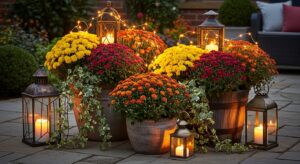
Planters don’t have to feature only plants adding decorative accents can elevate the look. Nestling lanterns, fairy lights, or decorative gourds among your flowers can create a warm, glowing effect.
As the evenings grow longer, these cozy additions make your outdoor space feel more inviting and extend its use well into the cooler nights of fall.
For a polished design, choose warm-toned lights that complement the rich colors of autumn.
9. Layered Heights and Textures
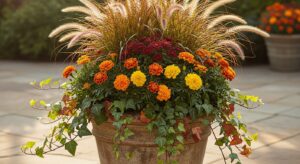
A well-designed planter should have balance and visual depth. This can be achieved by layering plants of different heights and textures.
Use tall elements like ornamental grasses or branches in the back, medium-height plants such as mums or asters in the center, and trailing plants like ivy, sweet potato vine, or creeping jenny cascading over the edges.
This arrangement not only creates visual appeal but also makes the planter feel full and lush, ensuring it draws attention from every angle.
10. Transition into Winter
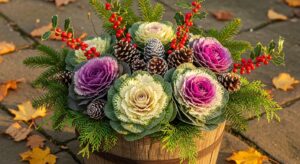
To make the most of your efforts, choose plants that can transition seamlessly from fall into winter.
Ornamental cabbages, evergreen sprigs, and heathers are hardy enough to withstand cooler weather.
Toward late fall, you can enhance your displays by adding pinecones, evergreen boughs, or holly branches, which bring a winter feel without requiring you to completely redesign your planters.
This approach allows you to enjoy stylish outdoor décor well into the holiday season.
Final Thoughts
Fall is a season of warmth, color, and natural beauty, making it the perfect time to refresh your outdoor space with creative planters.
From classic mums and pumpkins to rustic crates, ornamental kale, and cozy accents, there are endless ways to bring autumn charm right to your doorstep.
By mixing textures, colors, and seasonal elements, your planters will not only elevate your outdoor style but also create a welcoming atmosphere for family, friends, and guests throughout the season.